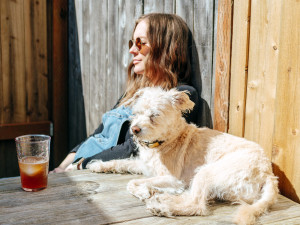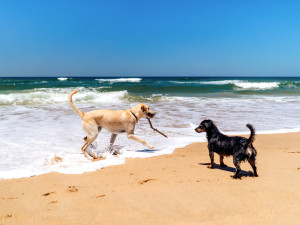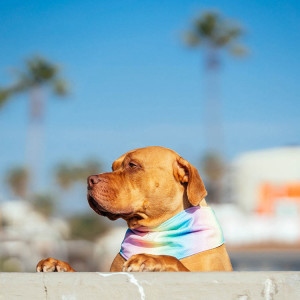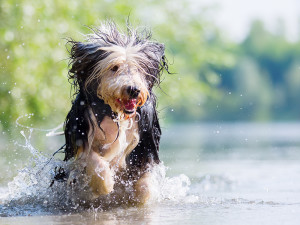Can Dogs Get Sunburns? Signs, Treatment
It’s good to know ahead of all the summer fun you’re gonna have together.

share article
In This Article:
Can Dogs Get Sunburns?opens in a new tab Signs of Sunburns on Dogs opens in a new tab How to Prevent Dog Sunburns opens in a new tab How to Treat Dog Sunburnsopens in a new tab
Your pup loves their warm sun spot, especially for taking long, luxurious naps. But as the weather warms up, it’s important to remember those rays can be as brutal as they are comforting. Yes, just like humans, dogs — especially those with short, light-colored coats or pink skin — can get sunburns. While sunburns may go unnoticed on dogs, it’s important for pet parents to understand the risks, recognize the signs, and take steps to protect their pups.
Can dogs get sunburns?
Most dogs love spending time being active outdoorsopens in a new tab, stretching out and relaxing in the yard, or yes, napping in that warm sunbeam inside the house. But all this sun exposure may cause pet parents to worry about the damage the sun can do to a dog’s skin. Veterinarians are commonly asked questions like, “Can white dogs get sunburns more easily than black dogs?” and “Can dogs get sunburns through their fur?” And pet parents are right to be concerned.
The ultraviolet radiation from the sun can damage dogs’ skin, causing sunburns. The severity of the sunburn depends on the thickness of a dog’s coat, the color of their coat, the pigment of their skin, the length of time spent in the sun, and the UV index while they’re outside. Sunburns can be tricky, because the first signs of a sunburn usually don’t show up until hours after exposure, and the severity of the burn may not be evident for days.
Signs of sunburns on dogs
Sunburns can show up on dogs in many different ways, depending on the amount of exposure and the skin’s sensitivity to sunlight. Some common signs of sunburns on dogs include:
Redness or pinkness of the skin
Most dogs will develop a color change to their skin, similar to the classic sunburns seen on people. This is usually most obvious in light-colored dogs and in areas where the coat is thin.
Dry, cracked, or flaky skin
As a sunburn progresses, you may see the damaged areas of skin start to peel. This can look different from the way sunburns usually peel in people. As dog skin processes sun damage, it may shed small flakes (resembling dandruffopens in a new tab) or larger whitish to yellowish crusts. These crusts will often be thicker than expected, because the dead skin cells get caught in the hair and build up before coming off.
Hair loss
Severely sunburned areas may develop complete loss of hair or have thinner hair due to damaged hair follicles. Thick crusts of dead skin can take chunks of hair with them as they peel off as well.
Pain when touched
Sunburns are burns, and burns are painful. Dogs with sunburned skin may shy away from being petted in tender areas or may hide or seem lethargic due to pain. Bad sunburns over large areas can make a dog seem stiff, sore, and grumpy.
Blistering
Before sunburned skin peels or flakes off, it may develop a fluid-filled blister beneath its damaged outer layers. Dogs aren’t great at leaving things alone, so they may rupture these blisters by licking or scratching before you ever see them.
Development of skin cancers
Chronic exposure to the sun can result in skin cancer in dogs. The ultraviolet radiation from the sun damages the DNA in skin cells. Every sunburn increases the risk of cancer because this damaged DNA can cause cells to mutate and grow out of control. Dogs don’t seem to get melanoma opens in a new tab from sun exposure like people do, but they can develop cutaneous hemangiosarcomaopens in a new tab or squamous cell carcinoma due to sun damage.
Areas most prone to sunburns
Dogs can get sunburns anywhere, but the areas most prone to sunburns tend to have non-pigmented skin and thin or absent hair. Some of the most common sites for dog sunburns include the:
Bridge of the nose (muzzle)
Belly
Inner thighs
Ear tips
Non-pigmented areas of the nose
Edges of the lips
Eyelids
Armpits
Previous injuries or certain medical conditions can also lead affected areas to be more prone to sunburns:
Scars
Surgical sites (especially if hair is clipped)
Allergies
Radiation therapy
Barbering (chewing at hairopens in a new tab)
Alopecia
Skin parasites
While having a lighter or thinner coat does make it easier for dogs to get sunburns, dogs with thick, dark-colored fur are susceptible to a different type of sun injury. Dark hair absorbs heat more readily than light hair, and a thick coat can help to trap that heat. A syndrome of solar thermal injury has been seen in dogs with thick, dark coats that spend a long time in direct sunlight. The sun can heat the haircoat up so much that it causes a thermal burn, generally along the length of a dog’s back.
Dogs with solar thermal injury often don’t show any symptoms at the time of the injury, but severe burns can develop over a period of days to weeks after an event. These burns are usually much more severe than those from a simple sunburn, can take weeks to heal, and may result in chronic scarring.
How to prevent dog sunburns
Prevention is key to keeping your dog’s skin safe from the sunopens in a new tab. Knowing how to prevent a dog from getting sunburns can help keep your pup safe from cancer and painful sun injuries. Dogs don’t think about the UV index before they go outside, so you’ll need to be aware of the weather before taking your canine companion out to spend time in the sun.
Limiting sun exposure
The best way to prevent dog sunburns is to keep them out of the sun. This means avoiding letting them out during the hottest part of the dayopens in a new tab, usually 10 a.m. to 3 p.m.
Providing shade
If your dog insists on being outside, or if you’re in a situation where your dog is outside with you on a sunny day, make sure there’s a shady place for them to retreat to. Shade will block most of the harmful UV radiation and keep your dog safe from the sun. It’s also helpful in preventing your dog from overheatingopens in a new tab, which carries its own set of dangers.
Using dog-safe sunscreen
Sunscreen helps prevent sunburns by blocking the UV rays from reaching the skin. An effective sunscreen for dogs has the following features:
Protects from both types of UV radiation that can harm your dog’s skin (UVA and UVB)
Has a sun protection factor of at least 30 (SPF 30+)
Dries quickly
It’s fragrance-free
Clear when applied
There are dog sunscreens available, but a baby-safe, spray-on sunscreen can be a good option as well and may be easier to get your hands on. Just read the label closely and make sure that there’s no “harmful if ingested” warning on it. You may never see it, but you can be sure that your dog will try to lick the sunscreen off at some point.
Protective clothing
Using clothing like sun shirts may help protect dogs with large areas of exposed skin, like hairless breeds or those with skin conditions. These are unlikely to cover all problem areas though, so be sure to apply sunscreen to any unprotected patches of skin. If your dog is going to be very active outside, keep a close eye on them because wearing clothes may make it easier for them to overheat.
How to treat dog sunburns
Prevention is the best policy, but it’s helpful to know how to treat a dog’s sunburn if a problem ever develops. If you’re concerned that your dog has a sunburn, take pictures and contact your vet’s office for advice and guidance before attempting any treatments.
They may recommend some strategies to help keep your dog comfortable while the sunburn heals, such as:
Cooling the area
If your dog accidentally spent some time out in the sun without protection, cooling their skin off can help to reduce continued injury and provide some comfort. Wiping them down with a cool, damp cloth or giving them a quick bath is ideal. Avoid using ice packs or ice baths, as these can sharply reduce blood flow to skin and cause further damage.
Applying aloe vera or pet-safe moisturizers
Aloe vera doesn’t do anything to prevent sunburns, but it may provide a soothing sensation and reduce inflammation in mildly sunburned skin. Do not use aloe vera on severe burns or open wounds.
Seeking veterinary care
See your vet if you feel your dog is in pain due to a sunburn, or if you notice symptoms beyond mild pinkness of the affected skin. Your vet can assess the affected areas, make sure the damage looks consistent with a sunburn (other skin problems can look similar), and help you with strategies to help your dog’s skin heal.
Using pet-safe pain relief medication
Your veterinarian may prescribe an anti-inflammatory pain medicationopens in a new tab or ointment if your dog seems like they are in pain because of their sunburn. Avoid over-the-counter human sunburn lotions and remedies. Many contain ingredients that are very harmful to dogs if they are ingested.
FAQs (People also ask):
How do you prevent dog sunburns?
Being aware of the dangers of sun injury is key to preventing sunburns. Taking precautions like using dog-appropriate sunscreen, providing shadeopens in a new tab, and staying indoors during the sunniest part of the day can help keep your dog safe.
How do you treat dog sunburns?
Treatment for mild sunburns on a dog is usually directed at soothing inflamed skin with topical or oral medications recommended by your vet. More severe burns may need chronic careopens in a new tab guided by your vet.
Do dogs need sunscreen?
Your vet may recommend a dog-safe sunscreen for outside activity. Sunscreen can help to protect unpigmented or thin-haired skin from damage due to ultraviolet radiation. Be aware of the dangers of too much sunopens in a new tab if you’re on the beach with your dog.
References:

Dr. Bartley Harrison, DVM
Dr. Bartley Harrison, DVM is a small animal veterinarian based in North Carolina who has practiced emergency medicine since graduating from the Texas A&M College of Veterinary Medicine. His primary interest areas include pain management, cardiology, and the treatment of shock.
He is a member of the Veterinary Emergency and Critical Care Society, American Veterinary Medical Association, and American Medical Writers Association. In addition to his clinical work, he writes pet health articles to help provide accurate information for both new and experienced pet parents. When he’s not working, he enjoys cooking, traveling, reading, and going on adventures with his dog.
Related articles
![large brown dog in a Canada Pooch cooling bandana]() opens in a new tab
opens in a new tabThe Best Gear to Keep Your Dog Cool on Hot Summer Days
This has been the hottest summer on record, and it ain’t over yet.
![Shepherd dog playing with yellow ball at the beach]() opens in a new tab
opens in a new tabHow to Keep Your Dog Safe at the Beach This Summer
5 tips to help your pup have fun in the sun — safely.
![Avoid heat stroke in dogs by sprinkling in the backyard with your dog]() opens in a new tab
opens in a new tabThree Dogs in Houston Died of Heatstroke. Here’s How to Prevent This
Temperatures are rising dangerously. Keep your pet safe with these tips.
![Australian shepherd panting with tongue out, walking ahead of owners.]() opens in a new tab
opens in a new tabHow to Keep Your Pets Safe During Extreme Heat Waves
As scorching summer temperatures become the new normal, here’s how to help keep your pets cool and healthy.
![Bearded Collie running in a lake]() opens in a new tab
opens in a new tabWhen Drinking Too Much Water Is Deadly
How to keep your swim fan safe.








